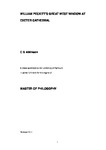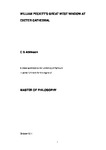William Peckitt’s Great West Window At Exeter Cathedral
| dc.contributor.supervisor | Smiles, Sam | |
| dc.contributor.author | Atkinson, Caroline Sarah | |
| dc.contributor.other | Faculty of Arts, Humanities and Business | en_US |
| dc.date.accessioned | 2011-11-15T13:08:50Z | |
| dc.date.available | 2011-11-15T13:08:50Z | |
| dc.date.issued | 2011 | |
| dc.identifier | 745139 | en_US |
| dc.identifier.uri | http://hdl.handle.net/10026.1/887 | |
| dc.description | Full version unavailable due to 3rd party copyright restrictions. | |
| dc.description.abstract |
This thesis examines the Great West Window at Exeter Cathedral designed by William Peckitt of York (1731-95). Peckitt was arguably the most important glass designer of the eighteenth century and undertook prestigious commissions at York, Oxford and elsewhere. In 1764 he was contracted by the Dean of Exeter, Jeremiah Milles, to supply glass to complete the restoration of the Cathedral’s glazing and to make the new window, which has often been considered to be his masterpiece. Peckitt’s Great West Window is no longer extant (although portions of it have been salvaged), having been replaced in 1904 with a window, designed by Messrs Burlison and Grylls, which was itself destroyed by enemy action in 1942. The Burlison and Grylls window was more in keeping with the Gothic revival aesthetic typical of the later nineteenth century and its proponents had argued forcefully that Peckitt’s Great West Window was an aberration that needed to be removed. The thesis provides initially an account of the debate that raged in the national press and beyond about the propriety of replacing Peckitt’s window. This documentary evidence gives a valuable insight into attitudes towards the adornment of churches at the turn of the century: should respect for the extant fabric include Peckitt’s one-hundred-and-fifty year-old contribution or should the building be renovated with a modern medieval-revival window. Until recent times it was largely the case that eighteenth-century glass was regarded as wholly inferior to the medieval glass that preceded it and it is widely accepted that glass making in Britain only recovered with the nineteenth-century Gothic revival and the modern glass that followed it. In this thesis it is suggested that the denigration of eighteenth-century glass and in particular that of William Peckitt at Exeter, ignores its qualities, practical and intellectual, and the Great West Window is used to reveal the seriousness of such endeavours. Peckitt’s work is positioned within the context of the particular circumstances of the restoration of Exeter Cathedral in the mid-eighteenth century under two successive Deans, Charles Lyttelton and the aforementioned Jeremiah Milles, both of whom were nationally significant antiquarian scholars. Peckitt was knowledgeable about medieval glass techniques, worked sensitively in restoring medieval glass and when designing a completely new window for the Cathedral worked closely with Milles to provide an iconographical scheme that was appropriate for the Cathedral, its history and its patrons. The evidence brought forward suggests that it is wrong to presume that glass designers like Peckitt had little understanding of medieval glass manufacture nor any interest in using the medium of glass appropriately in the context of a medieval building. | en_US |
| dc.language.iso | en | en_US |
| dc.publisher | University of Plymouth | en_US |
| dc.subject | Stained glass | en_US |
| dc.subject | Georgian stained glass | en_US |
| dc.subject | Eighteenth century gothic revival | en_US |
| dc.subject | William Peckitt | en_US |
| dc.subject | Exeter cathedral | en_US |
| dc.subject | The great west window of exeter cathedral | en_US |
| dc.subject | Picture glass | en_US |
| dc.subject | Eighteenth century stained glass | en_US |
| dc.title | William Peckitt’s Great West Window At Exeter Cathedral | en_US |
| dc.type | Masters | en_US |
Files in this item
This item appears in the following Collection(s)
-
01 Research Theses Main Collection
Research Theses Main



